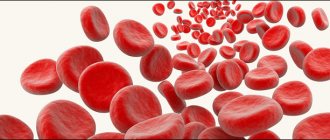Measles is an acute viral disease that is one of the most contagious and common infections. The causative agent of measles is an RNA virus of the morbillivirus genus, which is transmitted by airborne droplets. This virus has very low resistance to various influences (boiling, disinfection) and dies quite quickly outside the human body.
Although we are accustomed to thinking of measles as a common childhood disease, it is very dangerous. Every hour around the world, 15 people die from it, which amounts to 165,000 people a year. And before 1980, the number of deaths was 20 times greater! Mortality rates are particularly high in developing countries in Africa and Asia. There, 20% of child deaths are associated with measles. We managed to get rid of major measles epidemics thanks to universal vaccination. Children aged 1 and 6 years are vaccinated against measles, rubella and mumps. Even if vaccinated people get sick, they experience a mild form of the disease.
In this article we will look at measles in adults; detailed photographs of the disease will help us with this, as well as the first symptoms and current methods of treating measles; in addition, we will not forget to mention preventive measures, they will help avoid the disease and its dangerous complications.
How can you get infected?
Measles infection occurs through airborne droplets. The contagiousness index is 95%, that is, it is a highly contagious disease. To transmit the infection, direct contact with the patient is necessary; transmission of the virus practically does not occur through common things and third parties.
Cases of the disease are recorded all year round, but more often during the cold season. Children aged 4 and 5 years are most often affected. Babies under one year old who have received antibodies against the virus from their mother are immune in the first 4 months of life. In the future, the immune system weakens, and the child may become infected upon contact with a sick person. The patient remains infectious until the fifth day from the onset of the rash, and with complications until the tenth day.
The only bright spot in all this is the very powerful lifelong immunity after illness.
Belsky-Filatov-Koplik spots.
The period of the height of the disease (the period of rash) is characterized by the presence of a second wave of fever with intoxication, anorexia often develops, catarrhal syndrome persists (conjunctivitis may even intensify), which will be accompanied by specific measles exanthema. Catarrhal syndrome disappears by 7-9 days of illness.
The measles rash does not itch, is small- and large-spotty-papular, confluent, on an unchanged background of the skin. In severe cases or with a concomitant violation of primary hemostasis (thrombocytopenia, thrombocytopathy, some variants of connective tissue dysplasia, etc.), the exanthema can be hemorrhagic in nature. Pathognomonic for measles is the staged nature of the rash: on the 1st day, the rash appears on the face and neck, on the 2nd day - on the torso and shoulders, on the 3rd day - on the forearms and legs. The fading of the rash occurs in the same sequence, and when the rashes appear on the legs, they begin to fade on the face. After the rash, pigmentation remains (for 7-10 days) and pityriasis or fine-plate peeling.
Mild atypical forms of measles include abortive, mitigated, erased and subclinical. These infection variants develop in patients who have some specific immunity .
Abortion measles (“abortus” - break, interruption) begins and proceeds like typical measles until 1-2 days of rash. And then suddenly the disease ends: t0 normalizes, intoxication disappears, the rash no longer appears. On the affected areas of the skin, exanthema goes through all stages of development, as with typical measles (pigmentation, fine peeling).
Mitigated measles (“mitis” - mild) resembles rubella in its course: a short prodromal period, a mild intoxication syndrome and catarrhal syndrome, low-grade fever, no stages of rashes and Belsky-Filaty-Koplik spots, the rash is usually not abundant, has a rose-like and small-spotted character, The sequence of rashes may be disrupted. After the rash, pigmentation is not pronounced and disappears in 2-3 days.
The erased form of measles resembles a mild, 3-4-day ARI. There is no rash with it. The subclinical form is diagnosed only laboratory. An atypical course of measles can be suspected only taking into account epidemiological data.
Atypical variants with an aggravated (severe) course include hypertoxic and hemorrhagic forms. The first is characterized by the development of neurotoxicosis against the background of severe measles with corresponding symptoms (shallow and short-term disturbances of consciousness, signs of intracranial hypertension with vomiting and possible generalized convulsions, the phenomenon of meningism in the study of cerebrospinal fluid, etc.). The hemorrhagic form of measles, in contrast to severe measles with elements of a hemorrhagic rash, is characterized by severe SIRS, the development of disseminated intravascular coagulation syndrome and multiple organ failure syndrome (MODS), which can lead to death in the patient.
Incubation period
After a pathogen (the causative agent of measles) enters the human body, the incubation period of the disease begins, which lasts 7-21 days. At this time, there are no symptoms of the disease and the patient in this phase of the disease does not complain of deterioration in health.
At the end of the incubation period and in the first 5 days of the rash, the patient is able to infect another person with the disease. After the initial stage is completed, catarrhal disease begins.
Symptoms of measles in adults
When measles occurs in adults, the main symptoms remain the same as in children, but the severity of the disease in an adult will be more pronounced. This is especially noticeable during the period of rashes, during bacteremia, when the virus multiplies intensively in the blood.
The main symptoms of measles in adults are:
- increase in temperature (fever) up to 38 - 40 ° C;
- headaches, weakness;
- decreased appetite;
- conjunctivitis, rhinitis, photophobia;
- dry, hacking cough;
- hoarseness of voice;
- measles enanthema - large red spots on the soft and hard palate;
- rash on the skin (on the face, torso, arms, legs);
- possible delirium, impaired consciousness;
- intestinal dysfunction, etc.
The incubation period for measles infection lasts 1-3 weeks in adults. In the typical course of the disease, three successive stages can be distinguished: catarrhal, rash and convalescence stages.
- Catarrhal period (initial). Measles is commonly associated with characteristic skin rashes. But the first symptoms of the disease that appear after the incubation period expires are simple manifestations of a cold: a significant increase in temperature, cough, runny nose, asthenic syndrome. At this moment, you may suspect that you have an acute respiratory infection or acute respiratory viral infection, but characteristic signs in the form of skin rashes will allow you to make a correct diagnosis.
- Stage of formation of rashes. On the fifth day, rashes appear on a person’s skin. They spread from top to bottom - first the rash appears on the face, behind the ears, on the scalp, then spreads to the torso and arms, and then spreads to the legs. Measles manifests itself as a typical profuse bright red rash in the form of spots that tend to merge. The rash lasts on the skin for 1 - 1.5 weeks and is maculopapular in nature. The pigmentation that appears at the site of the rash also has a descending nature, that is, it appears in the direction from the head to the feet.
- Convalescence stage. Starting from the fifth day after the appearance of the red rash, the disease regresses and the person begins to recover. The temperature gradually decreases to normal levels, and the rash peels off. It is worth remembering that skin manifestations may disappear slowly over two weeks, while during this period of the disease the person is no longer contagious.
In adults, measles is especially severe. Pneumonia and bacterial complications are often associated with the underlying disease. Sometimes the disease can result in blindness and significant hearing loss.
One of the most dangerous complications of measles is viral meningoencephalitis (inflammation of the meninges), leading to death in 40% of cases. The measles virus greatly suppresses the immune system of an adult, as a result of which chronic diseases worsen and new ones are acquired.
Measles - symptoms and treatment
Incubation period
The incubation period for the typical form is from 9 to 11 days (in some cases up to 13).
Symptoms of measles in adults
The onset of the disease is subacute (i.e., the main syndrome appears 2-3 days from the onset of the disease), however, with proper preparation of the doctor (identification of pathognomonic enanthema - a rash on the mucous membranes), an acute onset can be determined (during the first day). In adulthood, due to the characteristics of the immune system, these criteria may not be met.
Measles syndromes:
- syndrome of severe general infectious intoxication;
- pathognomonic enanthema syndrome (Belsky-Filatov-Koplik spots);
- maculopapular exanthema syndrome;
- conjunctivitis syndrome (severe);
- respiratory tract syndrome (pharyngitis, tracheobronchitis);
- generalized lymphadenopathy syndrome (GLAP);
- hepatolienal syndrome.
The so-called early diagnosis of measles is described, including:
- difficulty in nasal breathing;
- redness of the right eyelid;
- low-grade fever (permanent fever).
Typical complaints of patients : increasing weakness, lethargy, loss of appetite, sleep disturbances, “sand in the eyes”, swelling of the lower eyelids, sometimes a runny nose, increased body temperature (up to 39°C). Then a sore throat develops, a dry cough appears, shortness of breath, there may be abdominal pain, diarrhea (layering of secondary flora), a rash appears (with its appearance, the syndromes of general infectious intoxication and damage to the respiratory tract intensify).
Objectively: one can note the occurrence of a maculopapular rash, which appears in typical cases on the 3-4th day of illness, with pronounced stages (face, neck; then the trunk, arms, thighs; then the deer and feet, and at this moment the face turns pale). The rashes are papules surrounded by a red spot, prone to fusion (but in the presence of clear areas), and sometimes petechiae appear. After 3-4 days, the rash becomes pale and leaves behind brown spots and pityriasis-like peeling. Peripheral lymph nodes (occipital, posterior cervical and axillary) increase in size and become sensitive. Conjunctivitis is pronounced (the conjunctiva is massively hyperemic, edematous, and purulent discharge quickly appears). The patient's appearance is characteristic: a puffy face, red (like a rabbit's) eyes, swelling of the nose and eyelids, dry cracked lips. On auscultation, dry rales are heard in the lungs. Tachycardia and decreased blood pressure are pronounced. The size of the liver and spleen increases (generalization of infection).
During pharyngoscopy, hyperemia of the soft palate is visualized in the oropharynx; on the mucous surface of the cheeks at the beginning of the disease, Belsky-Filatov-Koplik spots (small whitish spots with a narrow reddish border), which disappear when exanthema appears. Sometimes spotted enanthema appears on the mucous membrane of the soft palate.
Mitigated measles has been described (in people who received specific anti-measles immunoglobulin during the incubation period), characterized by an extended incubation period to 21 days and a mild course.
The abortive form of the disease has a typical onset, but after 1-2 days the clinical manifestations disappear.
There is a concept - a reaction to vaccination (during the initial administration of a live measles vaccine), characterized by an increase in body temperature, catarrhal symptoms (inflammation) of the upper respiratory tract, a scanty, inconspicuous rash (more often develops in children and people with immunodeficiency).
In patients with severe immunodeficiency - AIDS (HIV, cancer patients, people receiving systemic cytostatics after organ transplantation) - the course of the disease is extremely severe (mortality rate up to 80%). [4][5]
Differential diagnosis
| signs | measles | rubella | pseudotuberculosis | allergic rash |
| inc. period | 9-11 days | 11-24 days | 3-18 days | up to 24 hours |
| epidemiological background | contact with the patient | contact with the patient | eating raw vegetables | contact with an allergen |
| inflammatory changes in the upper respiratory tract | expressed | moderately expressed | moderate or absent | No |
| conjunctivitis | expressed | weakly expressed | weakly expressed | No |
| GLAP (enlargement of lymph nodes) | expressed | pronounced (occipital and posterior cervical) | moderate (mesadenitis) | No |
| nature of the rash | maculopapular | small-spotted | punctate, scarlatiniform, maculopapular | maculopapular, pruritic |
| time of rash appearance | 3-4 day | 1 day | 2-4 days | up to 24 hours |
| stage of rashes | expressed | No | No | No |
| pathognomonic signs | Belsky-Filatov-Koplik spots | Forchheimer's spots | "gloves and socks" symptoms | No |
Atypical course of measles
There is a typical and atypical course of measles. The typical clinical picture was described above. An atypical course is as follows:
- Erased (mitigated) form of measles. It occurs in a very mild form and occurs with the administration of gamma globulin or immediately after vaccination against measles.
- Hemorrhagic form - accompanied by multiple hemorrhages, bloody stool and urine. The patient often dies from bleeding. With timely hospitalization and intensive care, the outcome can be conditionally favorable.
- Hypertoxic. Observed with increased intoxication. The patient may have a very high, persistent temperature, signs of meningoencephalitis, heart failure and other symptoms. This form requires immediate hospitalization.
Complications most often occur in adults with reduced immunity and in the elderly.
Measles
The incubation period of measles lasts 1-2 weeks, in cases of immunoglobulin administration it extends to 3-4 weeks. The typical course of measles occurs with a successive change of three stages: catarrhal, rash and convalescence. The catarrhal period begins with a rise in temperature and the development of signs of general intoxication. Fever can reach extremely high numbers, patients complain of intense headache, insomnia, chills, and severe weakness. In children, the symptoms of intoxication are largely smoothed out.
Against the background of intoxication syndrome, in the very first days a dry cough appears, mucopurulent rhinorrhea, conjunctivitis (accompanied by intense swelling of the eyelids) with purulent discharge, and photophobia are noted. Children have pronounced hyperemia of the pharynx, granularity of the posterior pharyngeal wall, and a puffy face. In adults, catarrhal symptoms are less pronounced, but regional lymphadenitis may occur (mainly the cervical lymph nodes are affected). Auscultation of the lungs notes harsh breathing and dry rales. Sometimes the disease is accompanied by weakened intestinal activity and dyspeptic symptoms (nausea, vomiting, heartburn, belching).
The first febrile wave usually lasts 3-5 days, after which the body temperature decreases. The next day, the temperature rises again and intoxication and catarrhal symptoms worsen, and Filatov-Koplik-Velsky spots are noted on the mucous membrane of the cheeks - a specific clinical sign of measles. The spots are located on the inner surface of the cheeks opposite the small molars (sometimes moving onto the mucous membrane of the gums), they are white areas slightly raised above the surface, surrounded by a thin strip of hyperemic mucosa (a type of “semolina porridge”). As a rule, when the rash appears, these spots disappear; in adults, they may persist during the first days of the rash period. At the same time or slightly earlier than the Filatov-Koplik-Velsky spots, enanthem appears on the soft and, partially, hard palate, which is red spots with a pinhead of irregular shape. After 1-2 days they merge and cease to stand out against the background of general hyperemia of the mucosa.
The total duration of the catarrhal period is 3-5 days in children and about a week in adults. After which comes a period of rash. The measles rash initially forms on the scalp and behind the ears, spreading to the face and neck. By the second day, the rash covers the torso and shoulders. On the third day, the rash covers the limbs and begins to turn pale on the face. This sequence of rashes is characteristic of measles and is a significant sign for differential diagnosis.
Measles rash is a bright maculopapular exanthema, prone to the formation of confluent shaped groups with intervals of unchanged skin. The rash in adults is more pronounced than in children; in severe cases, it can become hemorrhagic. During the period of rashes, catarrhal symptoms intensify and fever and intoxication worsen.
The period of convalescence begins 7-10 days after the onset of the disease (in adults, the duration of measles is longer), clinical symptoms subside, body temperature normalizes, the elements of the rash regress (similar to the order of appearance), leaving behind light brown areas of increased pigmentation, disappearing after 5- 7 days. At the site of pigmentation, pityriasis-like peeling remains for some time (especially on the face). During the period of convalescence, there is a decrease in the body's immune defense factors.
Mitigated measles is an atypical clinical form of infection that occurs in passively or actively immunized individuals, or in those who have previously had measles. It is characterized by a longer incubation period, mild or absent symptoms of intoxication and a shortened period of catarrhal manifestations. An exanthema typical of measles is noted, but rashes can appear on all parts of the body at once or in the reverse order (ascending from the limbs to the face). Filatov-Koplik-Velsky spots are often not detected.
Another atypical form is abortive measles - its onset is the same as in ordinary cases, but after 1-2 days the symptoms subside, the rash spreads to the face and torso, after which it regresses. Fever in the abortive form usually occurs only on the first day of the rash. Sometimes subclinical forms of measles are detected using serological techniques.
Treatment of measles in adults
Let’s make a reservation right away: a specific treatment that would fight the measles virus simply does not exist in nature. Therefore, treatment of measles in adults is symptomatic - it involves preventing the development of complications, alleviating the patient's condition - that is, the doctor focuses on the symptoms and fights them.
Measles is usually treated at home. The doctor will visit you periodically during this period and monitor the progress of the disease. He will prescribe you the necessary medications, recommend that you eat well and drink plenty of fluids, and also take vitamins A and C.
Treatment in the infectious diseases department of the hospital is required in the following cases:
- when serious complications appeared;
- severe course of the disease, severe poisoning of the body (intoxication);
- it is impossible to isolate the patient from other members of the team (in a boarding school or in the army).
At home, if the patient has a body temperature of more than 38.5 degrees, antipyretic drugs are prescribed:
- paracetamol;
- ibuprofen;
- ibuklin.
Antiviral drugs are prescribed:
- cycloferon;
- kagocel;
- ingavirin.
For a runny nose, vasoconstrictors are prescribed:
- rhinonorm;
- vibrated;
- tizin.
To relieve inflammation in the nasopharynx, use:
- miramistin;
- inhalipt;
- rinsing with chamomile, sage, calendula.
Antibacterial therapy is prescribed only when bacterial complications develop (for example, pneumonia, otitis).
Experts advise not to take risks, monitor your health, develop immunity, get vaccinated on time, and if you get sick, immediately contact a specialist for help and under no circumstances self-medicate.
Prevention
Undoubtedly, the most important method of prevention is vaccination. Vaccination of adults against measles is necessary, but it is better if the vaccination is given in childhood - at 1 year and at 6 years. But if this procedure is not carried out on time, there is no reason to be upset. Measles vaccination in adults is also carried out in two stages with a break of three months.
The most common complications of measles vaccination in adults are:
- temperature rise for 5-15 days (sometimes up to 40 degrees), which lasts up to four days. It can be brought down with antipyretic drugs, for example, paracetamol.
- In addition to fever, rhinitis, cough, and a small rash may also bother you.
Adults who have not had measles and have not received vaccinations should pay special attention to the symptoms that begin the development of the disease (and the first symptoms are very similar to a common cold) and never delay contacting a doctor and begin appropriate treatment.
Measles: Symptoms. Diagnostics. Treatment. Complications
Measles is an acute viral infectious disease characterized by a combination of catarrhal symptoms with a specific exanthema. The measles virus enters the body through airborne droplets. The incubation period lasts up to 2 weeks, sometimes up to 1 month. The catarrhal period of measles is manifested by cough, fever, and cervical lymphadenitis. It is replaced by a period of rashes with the staged appearance of rash elements characteristic of measles. Recovery begins 1-2 weeks after the onset of measles. Diagnosis of measles is carried out, as a rule, on the basis of clinical data. Treatment is predominantly symptomatic, aimed at reducing body temperature, detoxification, and increasing the body's resistance.
Characteristics of the pathogen
The measles virus contains RNA and belongs to the genus Morbillivirus. It is unstable in the external environment, inactivated by drying, exposure to sunlight, ultraviolet irradiation, and heating to 50 °C. The virus can survive at room temperature for 1-2 days; when refrigerated (optimum temperature for maintaining viability: from -15 to -20 ° C) it remains active for several weeks. The reservoir and source of infection is a sick person. Isolation of infection begins in the last 1-2 days of incubation, the entire prodromal period and continues throughout the 4 days of the rash period. In some cases, the time of contagion extends to 10 days from the appearance of exanthema. There are no asymptomatic carriers of measles. The measles virus is transmitted through the aerosol mechanism by airborne droplets. The patient releases the pathogen into the environment when coughing, sneezing, or simply when exhaling air and talking. The finely dispersed suspension is carried with the air current throughout the room. Due to the weak resistance of the virus, contact and household transmission is excluded. When a pregnant woman is infected with measles, transplacental transmission of the infection is possible. People are extremely susceptible to measles; after exposure, lifelong immunity remains. The disease usually occurs in childhood; in adults, measles is rare and is noticeably more severe. The peak incidence occurs in the winter-spring period; the minimum number of cases is recorded in August-September. The incidence of measles has decreased significantly recently due to routine vaccination of the population.
Pathogenesis of measles
The virus enters the body through the mucous membrane of the upper respiratory tract, replicates in the cells of their integumentary epithelium and spreads throughout the body through the bloodstream, accumulating in the structures of the reticuloendothelial system. The measles virus has a tropism for integumentary tissues (skin, conjunctiva, mucous membranes of the oral cavity and respiratory tract). In rare cases, the virus may infect the brain with the development of measles encephalitis. The epithelium of the mucous membrane of the respiratory system affected by the virus sometimes undergoes necrosis, opening access to bacterial infection. It is believed that the causative agent of measles can persist in the body for a long time, causing a slow infection leading to the occurrence of systemic diseases (scleroderma, systemic lupus erythematosus, multiple sclerosis, etc.).
Measles symptoms
The incubation period of measles lasts 1-2 weeks, in cases of immunoglobulin administration it extends to 3-4 weeks. The typical course of measles occurs with a successive change of three stages: catarrhal, rash and convalescence. The catarrhal period begins with a rise in temperature and the development of signs of general intoxication. Fever can reach extremely high numbers, patients complain of intense headache, insomnia, chills, and severe weakness. In children, the symptoms of intoxication are largely smoothed out. Against the background of intoxication syndrome, in the very first days a dry cough appears, mucopurulent rhinorrhea, conjunctivitis (accompanied by intense swelling of the eyelids) with purulent discharge, and photophobia are noted. Children have pronounced hyperemia of the pharynx, granularity of the posterior pharyngeal wall, and a puffy face. In adults, catarrhal symptoms are less pronounced, but regional lymphadenitis may occur (mainly the cervical lymph nodes are affected). Auscultation of the lungs notes harsh breathing and dry rales. Sometimes the disease is accompanied by weakening of intestinal activity and dyspeptic symptoms (nausea, vomiting, heartburn, belching). The first febrile wave usually lasts 3-5 days, after which the body temperature decreases. The next day, the temperature rises again and intoxication and catarrhal symptoms worsen, and Filatov-Koplik-Velsky spots are noted on the mucous membrane of the cheeks - a specific clinical sign of measles. The spots are located on the inner surface of the cheeks opposite the small molars (sometimes moving onto the mucous membrane of the gums), they are white areas slightly raised above the surface, surrounded by a thin strip of hyperemic mucosa (a type of “semolina porridge”). As a rule, when the rash appears, these spots disappear; in adults, they may persist during the first days of the rash period. At the same time or slightly earlier than the Filatov-Koplik-Velsky spots, enanthem appears on the soft and, partially, hard palate, which is red spots with a pinhead of irregular shape. After 1-2 days they merge and cease to stand out against the background of general hyperemia of the mucosa. The total duration of the catarrhal period is 3-5 days in children and about a week in adults. After which comes a period of rash. The measles rash initially forms on the scalp and behind the ears, spreading to the face and neck. By the second day, the rash covers the torso and shoulders. On the third day, the rash covers the limbs and begins to turn pale on the face. This sequence of rashes is characteristic of measles and is a significant sign for differential diagnosis. Measles rash is a bright maculopapular exanthema, prone to the formation of confluent shaped groups with intervals of unchanged skin. The rash in adults is more pronounced than in children; in severe cases, it can become hemorrhagic. During the period of rashes, catarrhal symptoms intensify and fever and intoxication worsen. The period of convalescence begins 7-10 days after the onset of the disease (in adults, the duration of measles is longer), clinical symptoms subside, body temperature normalizes, the elements of the rash regress (similar to the order of appearance), leaving behind light brown areas of increased pigmentation, disappearing after 5- 7 days. At the site of pigmentation, pityriasis-like peeling remains for some time (especially on the face). During the period of convalescence, there is a decrease in the body's immune defense factors. Mitigated measles is an atypical clinical form of infection that occurs in passively or actively immunized individuals, or in those who have previously had measles. It is characterized by a longer incubation period, mild or absent symptoms of intoxication and a shortened period of catarrhal manifestations. An exanthema typical of measles is noted, but rashes can appear on all parts of the body at once or in the reverse order (ascending from the limbs to the face). Filatov-Koplik-Velsky spots are often not detected. Another atypical form is abortive measles - its onset is the same as in ordinary cases, but after 1-2 days the symptoms subside, the rash spreads to the face and torso, after which it regresses. Fever in the abortive form usually occurs only on the first day of the rash. Sometimes subclinical forms of measles are detected using serological techniques.
Complications of measles
Measles is most often complicated by secondary bacterial pneumonia. In young children, inflammation of the larynx (laryngitis) and bronchi (bronchitis) sometimes leads to the development of false croup, which threatens asphyxia. Stomatitis is sometimes observed.
In adults, measles can contribute to the development of meningitis and meningoencephalitis, as well as polyneuritis. A rare but quite dangerous complication is measles encephalitis. Currently, there is a theory of the development of autoimmune diseases, according to which the measles virus may take part in the pathogenesis of these conditions.
Diagnosis of measles
Measles is successfully diagnosed based on clinical manifestations. A general blood test shows a picture characteristic of a viral infection: lymphocytosis against the background of moderate leukopenia (or the concentration of white blood cells remains within normal limits), plasmacytosis, increased ESR. In adults, decreased concentrations of neutrophils and lymphocytes and an absence of eosinophils may be noted. The results of specific bacteriological and serological studies (rarely used in clinical practice) are retrospective in nature. If pneumonia is suspected, a chest x-ray is required. If neurological complications develop, a patient with measles is advised to consult a neurologist, rheoencephalography, and EEG of the brain. A lumbar puncture may be indicated to diagnose meningitis.
Treatment of measles
Measles is treated on an outpatient basis, patients with a severely complicated course are hospitalized, or for epidemiological reasons. Bed rest is prescribed for the entire febrile period. Sufficiently effective etiotropic therapy has not yet been developed; treatment consists of alleviating symptoms and preventing complications. As a measure to reduce toxicosis, drinking plenty of fluids is recommended. Intensive detoxification measures are carried out in cases of extremely severe cases. Patients need to maintain oral and eye hygiene and avoid bright light. Antihistamines, antipyretics, vitamins and adaptogens are prescribed as pathogenetic and symptomatic therapy. In the early stages of the disease, taking interferon significantly improves the course. If there is a threat of a secondary infection, broad-spectrum antibiotics are prescribed. Measles encephalitis requires high doses of prednisolone and other intensive care measures.
Measles prognosis and prevention
Uncomplicated measles usually ends in complete recovery; no cosmetic defects remain after the rash. The prognosis may become unfavorable if measles encephalitis occurs. Specific prevention of measles consists of routine vaccination of the population with LCV (live measles vaccine). The first vaccination against measles is given to children at 12-15 months, revaccination is carried out at 6 years. Isolation of patients continues for up to 10 days, limiting contact with unvaccinated and not sick children - up to 21 days from the onset of the disease.








